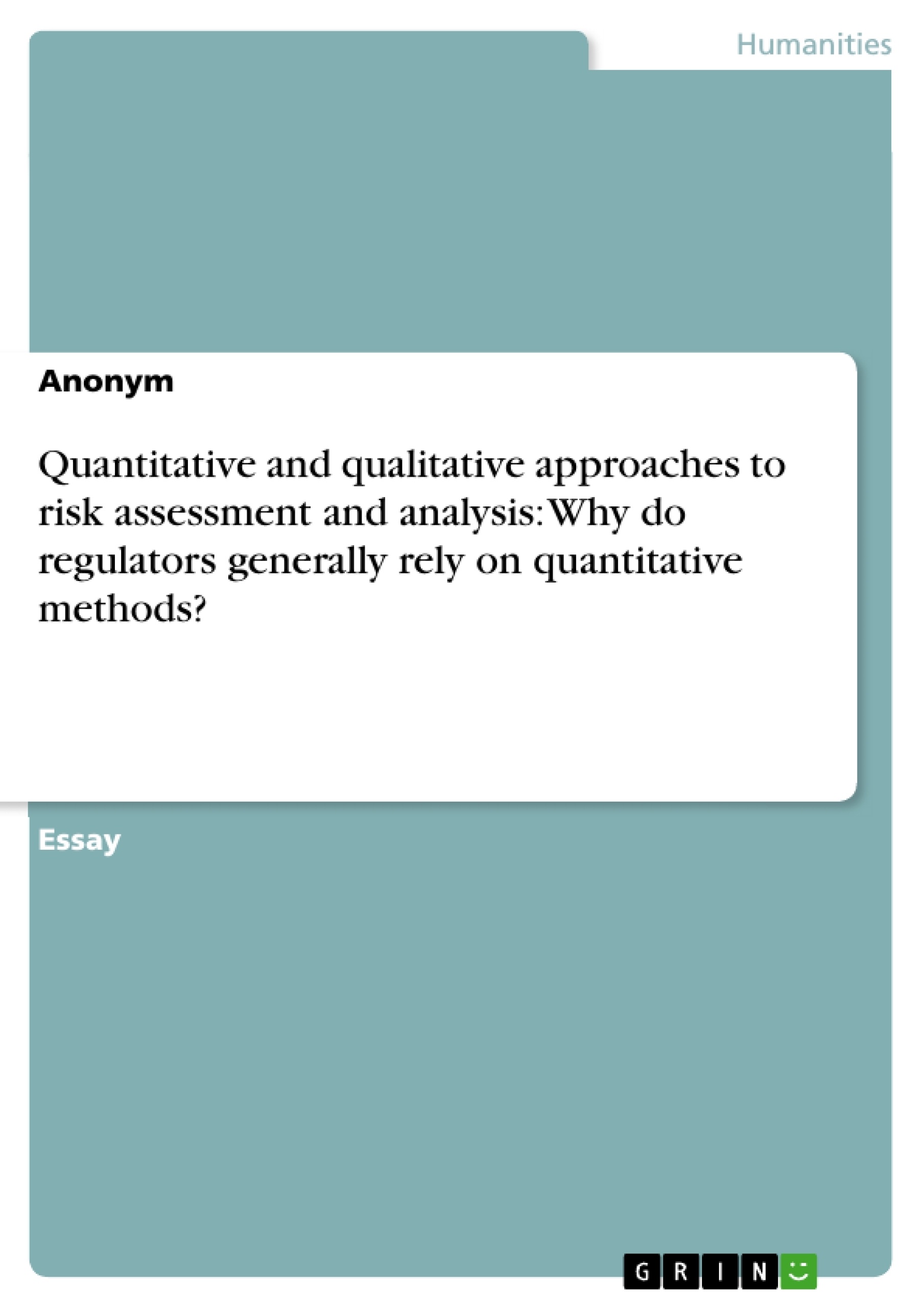The given question argues that there are two approaches to risk assessment and analysis, quantitative and qualitative, and asks why regulators generally rely on quantitative risk assessment and analysis. The essay examines the question by considering first what is meant by the terms risk, risk assessment and analysis, regulators and quantitative/qualitative approach to risk assessment and analysis. With reference to the latter terms, the essay then focuses on the analysis of advantages and disadvantages of both quantitative and qualitative approaches from the regulators’ perspective. By comparison of both approaches the essay then concludes with why regulators generally rely on quantitative methods.
Inhaltsverzeichnis (Table of Contents)
- Introduction
- Definitions
- Risk
- Risk assessment and analysis
- Regulators
- Quantitative/Qualitative approach to risk assessment and analysis
- Advantages and disadvantages of quantitative risk assessment approach
- Advantages and disadvantages of qualitative risk assessment approach
- Conclusion
Zielsetzung und Themenschwerpunkte (Objectives and Key Themes)
This essay aims to explore why regulators generally rely on quantitative risk assessment and analysis, despite the existence of both quantitative and qualitative approaches. It examines the definitions of risk, risk assessment and analysis, regulators, and the quantitative/qualitative approaches. The essay then analyzes the advantages and disadvantages of both quantitative and qualitative methods from the regulator's perspective, comparing both approaches to ultimately explain the prevalence of quantitative methods in regulatory practice. Key themes explored in the essay include:- The contrasting definitions of risk from natural sciences and social sciences perspectives
- The role of risk assessment and analysis in decision-making for both regulators and individuals
- The nature and function of regulators as institutions wielding power to influence individual conduct
- The advantages and disadvantages of both quantitative and qualitative risk assessment approaches
- The reasons for the prevalence of quantitative methods in regulatory practice
Zusammenfassung der Kapitel (Chapter Summaries)
Introduction
The introduction sets the stage for the essay by outlining the research question and the approach to answering it. The essay begins by defining key terms such as risk, risk assessment and analysis, regulators, and the quantitative/qualitative approaches. It then focuses on analyzing the advantages and disadvantages of both approaches from the regulator's perspective, ultimately concluding with why regulators generally rely on quantitative methods.Definitions
This section provides an overview of the different meanings attributed to the term "risk" by natural sciences, social sciences, and the general public. The essay highlights the different perspectives on risk, emphasizing the objective and subjective nature of risk perception. It introduces the contrasting definitions of risk as a product of probability and utility (natural sciences) and as a culturally constructed phenomenon (social sciences). The section also defines risk assessment and analysis, highlighting their role in risk management and decision-making. It further defines regulators as institutions capable of exercising power through legislation, noting the potential for both quantitative and qualitative data to inform their decision-making.Advantages and disadvantages of quantitative risk assessment approach
This section explores the strengths and weaknesses of quantitative risk assessment. It argues that quantitative risk assessment is suitable for targeting large populations, providing a long-term perspective, and promoting risk policy and rationality through expert knowledge. The section examines the use of quantitative methods in identifying population segments at risk, analyzing the effectiveness of risk reduction strategies, and promoting standardized risk management.Advantages and disadvantages of qualitative risk assessment approach
This section will delve into the advantages and disadvantages of qualitative risk assessment, considering its strengths in capturing subjective experiences, nuances, and cultural factors related to risk perception. It will likely explore the use of qualitative methods in understanding individual perceptions of risk, identifying culturally specific risk factors, and developing tailored interventions. The section will also address potential limitations of qualitative methods, such as challenges in generalizability and the potential for bias in data collection and analysis.Schlüsselwörter (Keywords)
The main keywords and focus topics of this essay include risk, risk assessment, risk analysis, regulators, quantitative risk assessment, qualitative risk assessment, natural sciences, social sciences, decision-making, power, legislation, and risk management.- Quote paper
- Anonym (Author), 2011, Quantitative and qualitative approaches to risk assessment and analysis: Why do regulators generally rely on quantitative methods?, Munich, GRIN Verlag, https://www.grin.com/document/272442



